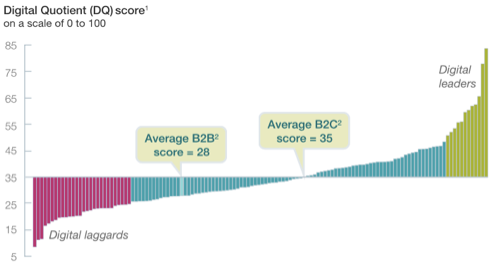B2B Transformation Requires Innovation
Are you feeling the shifting sands in the current business environment?
The business environment and the market are evolving at a rapid pace. Traditional business models aren’t producing the expected results nor the level of revenue required to maintain and grow the business.
Today’s environment requires a business to understand what is evolving around them and to also look inward to determine what is possible, what change is required and how a business can be positioned to maximize the highly dynamic and opportunistic digital economy.
Often what is possible and the change needed requires the consideration and move to a new business and cultural model. One that is built from overall business strategies recognizing and incorporating digital.
One that leverages technology, operational and cultural change.
The Changed B2B Marketplace
Why Innovation?
The lines between B2C consumers and B2B buyers are getting harder and harder to delineate.
Business buyers are shaping their purchasing behaviors based on their consumer experiences. If you disagree, just take a moment and reflect on how you move through awareness, consideration and decision to solve a problem you have or a need that you want to fulfill.
As a quick aside, we at 2040 would represent most companies and organizations need to consider a move to B2P (Business to Professional).
Our B2P strategy and framework recognizes the importance of the individual and the need to demonstrate a correlated value proposition with direct and personalized benefits. A value proposition that matches the needs they are attempting to fulfill and the problems they are needing to solve. A strategy and framework that recognizes the behavioral convergence.
The Digital Economy and B2B
As we often discuss and demonstrate, Digital is the cause and impetus driving changed behaviors and ultimately the disruption of your formerly successful results producing business model.
Some points to consider:
- B2B Buyer behavior has become more consumer-like.
- Business customers are exposed to the same dynamics, community networks and opinions that influence individual consumers.
- Nearly 50% of all B2B purchases were made on digital platforms in 2015.
- 71% of B2B researchers start their research with a generic search. (Google, 2015)
- B2B researchers do 12 searches on average prior to engaging on a specific brand’s site. (Google, 2014)
- 49% of B2B researchers who use their mobile devices for product research do so while at work. (Google, 2015)
- 47% of B2B buyers viewed 3-5 pieces of published digital content before subscribing.
- 96% of B2B buyers want content with more input from industry thought leaders.
B2C in reality is farther ahead in attempting to accommodate and survive in the new digital economy.
B2B in most cases is behind.
Why?
Many B2B businesses are holding strong to operations, processes, models, marketing tactics and sales approaches that previously worked well for them. B2B buyers, did indeed, think and act differently than B2C consumers just a few short years ago.
That isn’t the case anymore as the convergence of information access, mobile and social come together blurring the lines between professional and personal behaviors, consumption and attention.
Why B2B may not be performing as well as their B2C counterparts?
It is a challenging and complex answer and one that a blog post can’t aspire to address in short form. I will, however, bring forward some of the findings from a recent McKinsey survey that compound the above mentioned behavioral impacts.
The results below demonstrate there are a variety of issues. The most important and telling are the lack of a holistic strategy (one that includes digital), executive leadership and investment in digital transformation and technologies.
Some of the pertinent survey findings:
- B2B companies are behind B2C companies in how they use digital tools and data to set strategy.
- Most consider overall strategy and digital strategy to be different.
- Most B2B players haven’t taken concrete steps to mobilize the organization around digital tools and data.
- Only 10 percent see digital as one of their top three investment priorities, about half the average for B2C companies.
- Digital strategies are often fragmented across the enterprise.
- Fewer than 24 percent of executives understand how their industries are being disrupted by digital.
The findings paint a challenging picture and state of the industry. The answer, well, really the requirement, should be focused around transformation and innovation.
- What do I need?
- What is our strategy?
- How do we change?
- How do we adapt?
- How do we evolve?
All with a call to action containing more urgency that you have ever created or felt before.
Time is short.
Innovation and Models
The consideration of the new business model and building a culture to accommodate will require you to consider embodying innovation.
Innovation can lead to a greater understanding of what is possible and reveal what may offer transformative value that leads to greater relevance and revenue.
- It requires thinking very differently than you have in the past.
- It requires moving beyond looking in the rear-view mirror at what worked in the past.
- It requires releasing your business from the shackles of operational models of the past.
- The past isn’t relevant anymore.
Innovation aids the evolution (or revolution if needed) of the business model and operational model to maximize, grow or expand market focus (matching supply and demand).
Innovation can be what creates sustainability and growth in a highly dynamic digitally stimulated environment.
Innovation can enable agile and nimble adjustments to the model and culture that will rattle formerly successful processes and methods.
Although disruptive, it will lead to creating the structure needed to respond and compete.
Your Path Ahead
Your path ahead isn’t taking a Red Queen approach, falling into a spending trap and copying what worked for a competitor or other company.
The path ahead needs to bring forward a unique strategy and vision that is representative of your business, your content, your customers and your target markets.
You should conduct some of your own research and gain insight into what others are doing to get some ideas. There are many great examples of companies transforming and adapting. I mention some of those in my Niche Media blog posts.
Connectiv Innovation Awards
Another great source of success and best practices will come this September in NYC. Connectiv, The Business Information Association has launched a new awards program to recognize innovation in the B2B media and business information industry. An awards program that recognizes the necessity of change across culture, operations, models and technology.
The award program is focused on bringing forth the most innovative solutions to the biggest problems facing the media and business information industry. So many companies are entering to become part of the B2B industry transformation story.
If you are on your transformative path already and haven’t entered, you should. Don’t miss the opportunity to be recognized by your industry and share what has brought you success.
As always, we are here to help you through your transformation, creation of strategy and aid you in moving to a new revenue and operational model. Contact us today.
PS: Don’t forget to check out the Connectiv Innovation Awards and watch the video. (I am in the video talking about the importance of innovation and the awards program)





